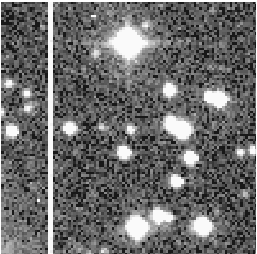SPACEWATCH® Discovery of Minor Planet 2000 WR106


Observation date: 2000 November 28
(North is to the right, east at bottom in this set of images.)
During routine scanning with the SPACEWATCH® 0.9-meter telescope on 2000 November 28, observer R. S. McMillan was manually blinking the displayed scans in real time and noticed this relatively slow-moving object. Its rate of motion was too slow for the real-time software to detect; normally the slower objects such as this one are found with another program that processes the data off-line.
The target was subsequently reobserved by J. A. Larsen, whose observing shift followed McMillan's. With their 12 observations spanning 3 nights, The Minor Planet Center determined a preliminary orbit that suggested the object is 43 AU from the Sun and 42 AU from the Earth. With an apparent magnitude of 20 at those distances, the object would be one of the brightest known Trans-Neptunian Objects other than Pluto and its satellite Charon.
Subsequent to that original announcement, an image of the object was found by A. Knofel and R. Stoss on an old photographic plate taken with the Big Schmidt telescope at the Palomar Observatory in 1955, about 3 degrees away from the backward extrapolation of the approximate orbit determined in December 2000. This means that the motion of the object around the Sun has been measured over an arc of 57 degrees, enough to establish that the orbit is slightly eccentric and has a mean distance from the Sun 43 times farther than the radius of the Earth's orbit. Observations in December 2000 from observatories in Japan, Hawaii, and Arizona also helped to refine knowledge of the orbit, which indicates that the object is a member of the classical Kuiper Belt.
The orbit is now known well enough that the Minor Planet Center has assigned 2000 WR106 a permanent number; it is minor planet (20000). This makes the object eligible for naming. According to the guidelines set by the International Astronomical Union's Committee on Small Body Nomenclature, it should receive a name from among those of creation gods.
Furthermore, the submillimeter and optical measurements required to determine the object's thermal output, reflectivity, and size have been made by D. Jewitt, H. Aussel, and A. Evans from observatories on Mauna Kea in Hawaii. They indicate the object is relatively dark compared to Pluto and is about half the diameter of that planet. So 2000 WR106 is indeed one of the largest, as well as one of the brightest, of the Trans-Neptunian population excepting Pluto and Charon. The darkness of the surface tells us there is very little surface frost. (Dave Jewitt: Size and Albedo of Kuiper Belt Object (20000) Varuna)
2000 WR106 was discovered in a moderately rich star field, closer to the galactic equator than where most TNOs are deliberately sought. This may explain why it had not been discovered earlier.
2001 March 6:
Minor Planet (20000) 2000 WR106 has been named by the IAU. It is now known as Minor Planet (20000) Varuna. See a copy of the citation. This object was also recently found to have a lightcurve with a relatively large amplitude. (IAUC 7583)

